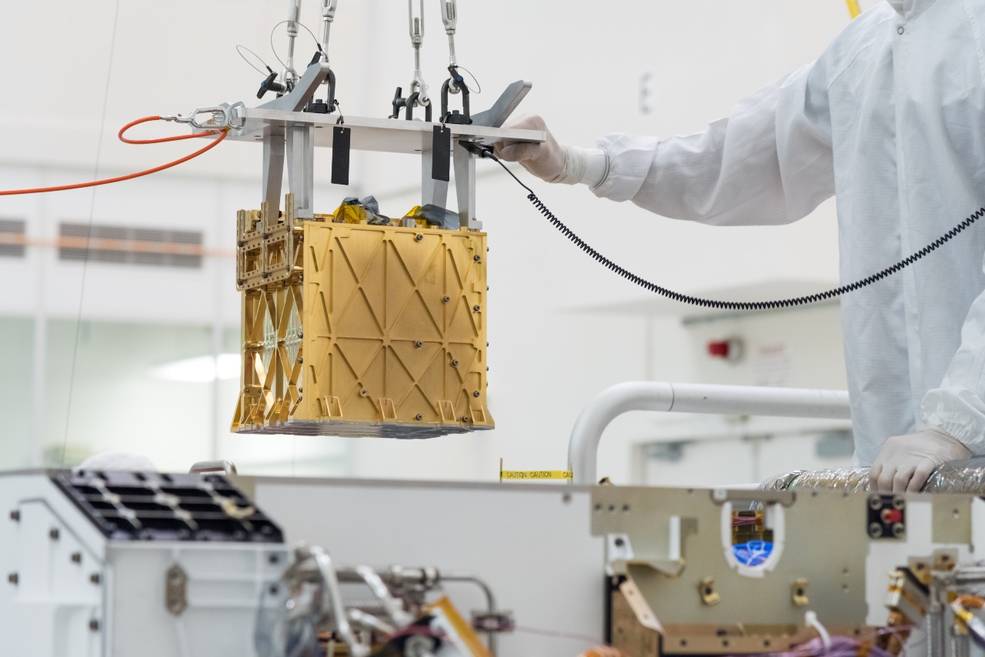The rover has produced almost 5.4 grams of oxygen in an hour, which is equivalent to 10 minutes of breathable oxygen for an astronaut.
NASA's newest six-wheeled robot, Perseverance Rover, has created history by extracting oxygen from Martian carbon dioxide. This is the first time oxygen has been produced on another planet, said the space agency on Wednesday.
Another huge first: converting CO2 into oxygen on Mars. Working off the land with what’s already here, my MOXIE instrument has shown it can be done!
— NASA's Perseverance Mars Rover (@NASAPersevere) April 21, 2021
Future explorers will need to generate oxygen for rocket fuel and for breathing on the Red Planet. https://t.co/9sjZT9KeOR
The Perseverance Rover was sent to Mars to search for microbial life and water, and to collect rock and soil samples to be sent back to Earth someday. The machine carries several instruments, amongst which is a small, toaster-size, gold box-shaped tool called MOXIE (Mars Oxygen In-Situ Resource Utilization Experiment). On April 20, MOXIE successfully created oxygen from Mars' CO2-rich thin layer of the atmosphere through electrolysis.
"While the technology demonstration is just getting started, it could pave the way for science fiction to become science fact—isolating and storing oxygen on Mars to help power rockets that could lift astronauts off the planet’s surface," said NASA in their press release. Such technology can also be capable of producing enough breathable oxygen for future humans on the red planet.

NASA's Jet Propulsion Laboratory inserts MOXIE in the front right side of the rover, Credits: NASA/JPL-Caltech
In the first test, MOXIE has successfully split the carbon and oxygen atoms from the carbon dioxide molecules through chemical reactions. The process also leaves harmless carbon monoxide as a byproduct in the atmosphere.
Since the whole extraction process occurs in extremely high temperatures (around 1,470 degrees Fahrenheit/800 degrees Celsius), MOXIE is specially designed for heat endurance. It is made of 3D printed, heat-tolerant materials like nickel alloy and has a thin gold coating to stop high heat transmission to the rover.
Apart from producing oxygen for human breathing, the conversion process can also haul a sufficient amount of oxygen needed by rocket propellants to fly back to Earth from Mars.
"For both rockets and astronauts, oxygen is crucial", says Michael Hecht of MIT Haystack Observatory, MOXIE's principal investigator.
"To burn its fuel, a rocket must have more oxygen by weight. Getting four astronauts off the Martian surface on a future mission would require approximately 15,000 pounds (7 metric tons) of rocket fuel and 55,000 pounds (25 metric tons) of oxygen. In contrast, astronauts living and working on Mars would require far less oxygen to breathe. The astronauts who spend a year on the surface will maybe use one metric ton between them,” explains Hecht.
Currently, MOXIE is an experimental tool that can produce a maximum of 10 grams of oxygen an hour. NASA intends to run the device at least nine more times in a span of two Earth years( one Martian year). The trial runs will occur in three different phases, checking the instrument in the first phase, testing the tool under varied atmospheric conditions in the second phase. Lastly, MOXIE's operations will be tested under different temperatures to compare the outputs.

Illustration of MOXIE instrument, depicting the elements within the instrument. Credits: NASA/JPL
According to Hecht, a one-ton version of MOXIE will be able to produce approximately 55,000 pounds (25 tons) of oxygen needed for a rocket to take off from Mars. Making 25 tons of oxygen on Mars rather than carrying it from Earth is also a practical solution for future human exploration on the red planet. After the successful trial, MOXIE's engineers are now trying to step up the tool's oxygen output to a more significant amount.
The rover landed on Mars' 28-mile-wide Jezero Crater on Feb 18 after a 7-month journey in space. Its twin-rotor chopper, Ingenuity, has already made history by achieving the first successful powered flight on Mars. Ingenuity is scheduled for multiple fight plans, which will supposedly finish by mid-May. Meanwhile, Perseverance Rover has already recorded the sound of Mars for the first time and will continue to explore Jezero Crater in search of ancient lives once Ingenuity's flight plans are completed.
The Perseverance's primary mission remains to collect "biosignatures" and rock samples. The space agency targets to collect at least 20 different samples which can be analyzed on the Earth for further studies. However, the rock samples will be sealed and dropped on Mars' surface by the rover and picked up by another mission later.
This latest rover is built and managed by NASA's Jet Propulsion Laboratory in Southern California and continues to add feathers to its cap by making history.
To learn more about the Perseverance Rover, read here.
How excited are you about this discovery on Mars? Share in the comments.
